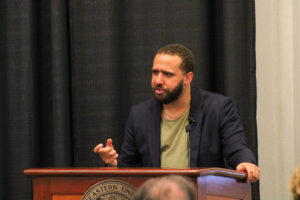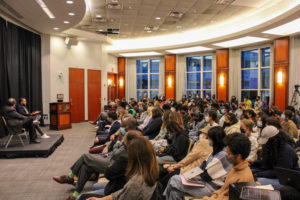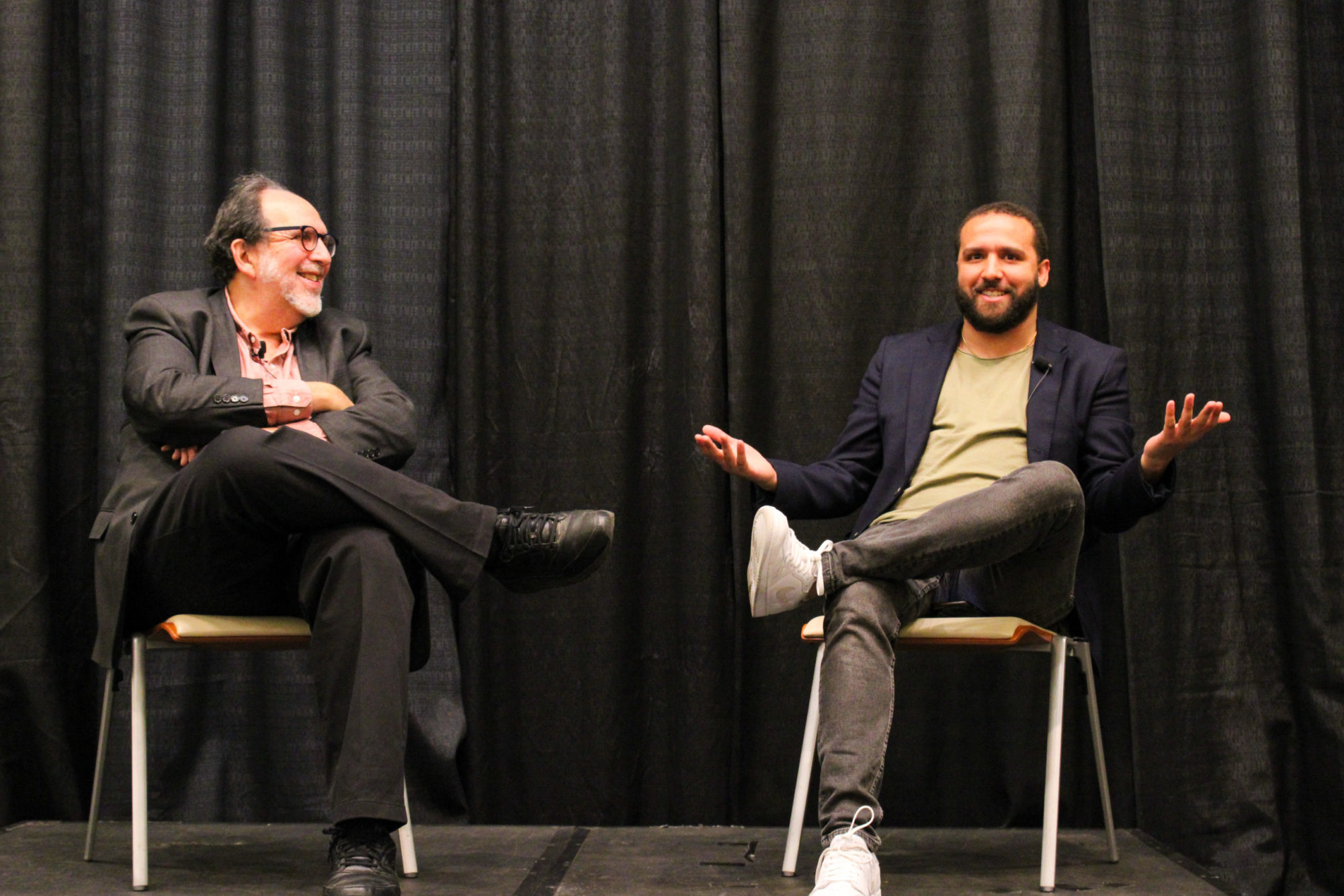When then-Washington Post correspondent Wes Lowery was sent to Ferguson, MO to cover the protests following Michael Brown’s death in 2014, he thought it would be a three-day project. It turned into three months, and eventually spawned a Pulitzer Prize-winning investigation into the use of deadly force by police.
Speaking to a packed room of Northeastern University students, faculty, and staff to kick off the first College of Arts, Media and Design Dean’s Distinguished Lecture since the pandemic, Lowery recounted this experience and how it changed how he thought about race and objectivity the newsroom.

As he interviewed Ferguson residents back in 2014, he said, he heard story after story of negative police interactions with Black residents. “Even as a young Black man,” he said, “I was still unwilling to fully believe some of these stories I was hearing,” he said.
That experience led him to think deeply about whose stories get told and who the storytellers are. In a majority of newsrooms, those storytellers are overwhelmingly white and writing for a majority white audience.
That thinking led to a widely-circulated New York Times op-ed at the height of movement for racial justice, in which Lowery argued that this lack of representation negatively impacts most media organizations’ ability to holistically cover Black and Brown communities and elevate the voices of journalists of color, joining a growing contingent of Black journalists publicly demanding an overdue paradigm shift in the profession.
Reflecting on that piece, he said that “too often, especially on issues of race, we are governed by the appearance of objectivity … When we decide not to use that word [racism], we’re not making an objective decision. This is not objective journalism. We’re making a decision to appease the biases of our white readership.”
In telling race stories, “Black journalists often have played the role of ombudsmen,” Lowery said. “Racism is wrong and we need to have the moral clarity to say that racism is wrong.”
“Although he is just 31, Wes Lowery is one of the country’s most accomplished journalists and is leading a nationwide discussion about the role of race in America’s newsrooms. This is an issue our students think about—and argue about,” said Jonathan Kaufman, Director of CAMD’s School of Journalism.
In fact, students packed the room to hear from Lowery – standing, perched on window sills, and even sitting on the floor when they exceeded the room’s seating capacity.
“Lowery’s thoughtfulness and approachability made him an ideal speaker,” continued Kaufman. “It was great to see so many students crowded into his standing-room-only lecture and eagerly talking with Lowery after he was done.”
Aspiring journalists lined up to ask for advice on how to gain a source’s trust, how to protect your mental health when covering difficult topics, and when breaking the rules might be necessary to tell a story.
Third-year journalism student Pavithra Rajesh, currently writing for the Christian Science Monitor through Northeastern’s cooperative education program, brought up a topic that Lowery has done a lot of thinking about.
“What I’ve noticed a lot of times in conversations when I’m talking about the news or pitching stories is, I very naturally look at the race angle in a lot of these stories,” she said. “In conversation with my largely American and white colleagues, that when I bring up stories like that or topics like that, they kind of look at me with this lens: ‘Oh there she is, the journalist of color bringing up the race angle again.’ So sometimes that makes me hesitate to bring up these stories especially as a student and someone who’s just working their way up. I don’t want to be cornered as ‘You’re the person who brings up the race stories and you’ll cover these stories and that’s it.’”
It all goes back to the overall lack of representation in newsrooms, Lowery said. “A lot of our mentors spent their careers not wanting to be seen as the ‘Black journalist,’” he said. “We’re of the post-Obama, Trayvon Martin generation … what other story would we ever cover? …The story of America is the never-ending reckoning for the original sin of slavery.”
“I also understand that my colleague might not have that perspective,” he added. “I’m the one with the pigment here so I might be the one thinking that and that’s fine, so let me be the one to say it. It’s unfortunate that that burden might fall that way. It wouldn’t be that way in an ideal world.”

This discussion reflects the increasing engagement CAMD students are having around issues of racial and social justice. The opening of CAMD’s new Center for Communication, Media Innovation, and Social Change will create more space for ongoing conversations on the most important issues in media and social impact, and how the skills students are learning can be used to create meaningful change now and in the future.
Learn more about the Dean’s Distinguished Lecture series here and watch the full conversation on CAMD’s YouTube channel.


